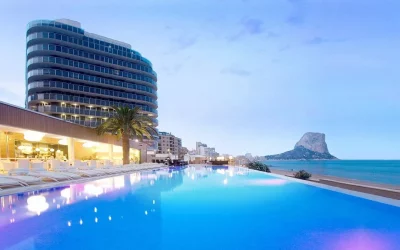Right in the heart of Calpe, just steps away from high-rise hotels, bustling promenades, and the iconic Peñón de Ifach, lies a natural oasis that surprises most first-time visitors — Las Salinas de Calpe.
This unique saltwater lagoon is more than just a pretty view with pink flamingos. It’s a place of ecological richness, historical importance, and peaceful contrast to the town’s busy beaches.
Let’s uncover the full story of Las Salinas — from Roman salt extraction to modern birdwatching.
📍 Where Are Las Salinas?
Las Salinas de Calpe sit between the two main beaches: Playa Arenal-Bol and Playa de la Fossa, just inland from the Peñón de Ifach.
You can’t miss it — the blue-green lagoon surrounded by reeds is clearly visible from the main roads and even more impressive when viewed from above (like during a hike up the Peñón).
🚶♂️ It’s fully walkable, with a public footpath circling most of the lagoon — perfect for a nature walk, photography, or a short detour on your way to the beach.
🧂 A Bit of History: Calpe’s Salt Legacy
Las Salinas didn’t just appear out of nowhere. They were once a thriving Roman saltworks, part of a vast network used to preserve fish and other foods before refrigeration existed.
🏛️ Historical Timeline:
2nd century AD: Romans begin extracting salt here, shipping it along the Mediterranean
Salt was used especially to preserve garum, a fish-based sauce widely consumed in Roman cuisine
Middle Ages: Salt production continues, becoming an important economic driver for Calpe
20th century: Industrial salt production declines, and the area is eventually protected as a natural park
Today, the salt basins are no longer used for industry — but the natural salt levels remain, creating a unique micro-ecosystem that draws in dozens of bird species.
👉 Link: Baños de la Reina
🦩 Wildlife & Birdwatching: The Stars of the Show
Without a doubt, the main attraction at Las Salinas is its resident flamingo population. These elegant, pink-tinged birds can often be seen:
Feeding in the shallows
Nesting in the reeds
Flying in formation across the lagoon
Other species you might spot:
Herons
Storks
Egrets
Gulls
Grebes
Occasionally ducks and migratory birds depending on the season
📸 Bring binoculars or a camera with a zoom lens — this is a favorite spot for birdwatchers and nature photographers!
💡 Did you know? Flamingos get their pink coloring from the algae and small crustaceans they feed on, which thrive in salty waters like these.
👉 Link: Wildlife on the Costa Blanca
🌿 Ecological Importance
Las Salinas is a protected natural zone due to its high ecological value. Despite being surrounded by urban development, it:
Supports native Mediterranean wetland ecosystems
Acts as a rest stop for migratory birds traveling between Europe and Africa
Is rich in salt-tolerant plants and brine-loving micro-organisms
Helps control humidity and temperature in the local microclimate
It’s one of the few places where urban life and wild nature coexist side by side.
👣 How to Visit
Getting There:
Easily reachable on foot from anywhere in central Calpe
Parking is available in surrounding streets and near the Peñón
Public buses also stop nearby
🛣️ Surrounded by Avenida Juan Carlos I and Avenida de Europa
Walk the Trail:
There’s a walking path that circles most of the lagoon, with benches and signage.
Some areas are more rustic — wear proper shoes if you plan to explore beyond the paved paths.
📸 Best Time to Visit
The flamingos and other birds are usually visible year-round, but they’re most active:
Early morning or late afternoon
During spring and autumn migrations
Sunrise and sunset offer the most beautiful reflections of the pink birds, calm waters, and the Peñón de Ifach in the backdrop.
🌅 Golden hour photography here is truly magical.
✅ Editor’s Conclusion
Las Salinas de Calpe is more than just a pond with flamingos — it’s a living connection to the town’s ancient past, a vital ecological haven, and a beautiful reminder of how nature and history intertwine in the Costa Blanca.
It’s quiet, peaceful, and completely free to enjoy. Whether you’re a birdwatcher, a curious traveler, or just someone looking to slow down — take the time to walk around the lagoon and witness Calpe’s natural side.
❓Frequently Asked Questions
Are the flamingos always there?
Yes, a population of flamingos lives there year-round, though numbers can increase during migration seasons.
Is it free to visit Las Salinas?
Yes, it’s an open natural space with public access.
Can I swim in the Salinas of Calpe?
No — swimming is not allowed. It’s a protected wildlife area.
Are there guided tours available?
Not officially, but some nature tour companies offer birdwatching experiences that include the Salinas.
Can I walk all the way around it?
Most of the lagoon has public paths, though some parts are fenced for protection. You can comfortably walk a large portion of it.







